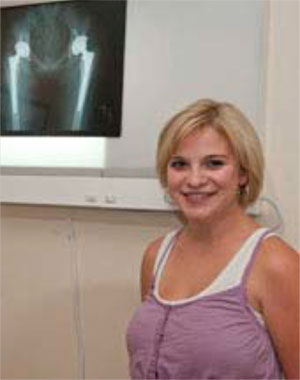Rachel Van Winkle was only nine years old when she and her family learned that she suffered from systemic juvenile rheumatoid arthritis — not a diagnosis any parent or child wants to hear.
The most common form of persistent arthritis in children under 16, SJRA is called “systemic” because it affects the whole body, bringing otherwise unexplained fevers, a rash and enlargement of the spleen and lymph nodes. The “rheumatoid arthritis” part of the name means that the autoimmune disorder causes pain and swelling of many of the body’s joints and their eventual degeneration. The condition also is sometimes described as “idiopathic” arthritis, meaning that the cause is unknown. Anti-inflammatory drugs and physical therapy can help, but when the condition is severe or advanced, joint replacement may be the only answer to maintain mobility.
Diagnosed first at St. Louis Children’s Hospital, Van Winkle was soon in the care of the Center for Adolescent and Young Adult Hip Disorders, where a conservative approach to joint preservation is the underlying philosophy, and comprehensive treatments are available. Center director John C. Clohisy, MD, says, “What we’re learning is that there are huge advantages to preserving the joint. Hip replacement may have to be done, but we don’t want to do it in young patients unless there is no other choice.”
In Van Winkle’s case, cartilage loss in the hip joint and the resulting pain of bone-to-bone contact meant that five years after diagnosis she had gotten as much use as possible out of her hips. The center’s physicians determined that complete hip replacements were called for, and Clohisy, professor of orthopaedic surgery, replaced her right hip when she was 14 and the left hip three years later.
Any decision to replace a young person’s hip joint comes only after careful consideration by the center’s members. According to Heidi Prather, DO, associate professor of orthopaedic surgery and a center physiatrist, “We are very specific about the patient’s history and physical exam, working together to diagnose, evaluate, and treat, looking at each problem from every angle.” The close cooperation among group members and their open communication contributes to the center’s clinical success, she says.
The second of Van Winkle’s hip replacements is now five years in her past, and she says that most people have no idea that she has had her hips replaced. “I don’t talk about it much, and my leg movement is as smooth as anyone’s,” she says. She sees Clohisy on a two-year schedule, and together they expect that she will get 25, perhaps 30, years of use out of her prosthetic joints.
Now 22, Van Winkle is preparing to graduate from college with a degree in fashion merchandising that she hopes will take her from her small Midwestern town to one of the country’s big fashion centers. Her future, entwined as it is with systemic arthritis, may well include the surgical replacement of other joints, but she takes the uncertainty in stride. “I just have that kind of luck to deal with,” she says.
